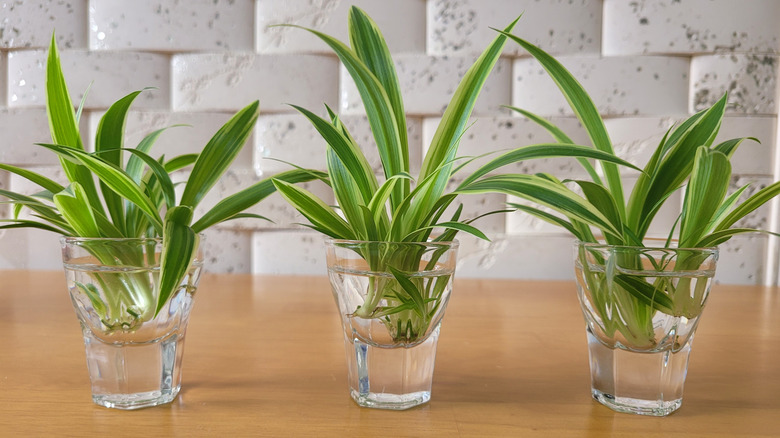The Budget-Friendly Way To Make Your Spider Plant Look Full & Bushy
Spider plants (Chlorophytum comosum) are a timeless favorite for houseplant enthusiasts. With a weeping crown of leaves and resilient nature, the spider plant is an easy houseplant to love. However, you may notice that your plant isn't looking as bushy as you'd like it to. There are a few ways to troubleshoot this issue, including watering it on a more regular schedule, repotting it, and placing it in a sunnier spot, all of which can improve the health and growth of the plant. If the plant is still looking leggy, consider interplanting it with your spider plant babies. It's an easy, budget-friendly way to make your spider plant bushier.
As any plant enthusiast knows, spider plants generously produce "baby" plants from slender runner stems that emerge from the center of the foliage. Also referred to as pups or spiderettes, these offshoots look like a mini pompom — a miniature copy of the mother plant. Under the right conditions, your spider plant will give you countless babies free of charge.
If your plant doesn't have any babies yet, don't fret. It might just be too young. If your mature spider plant isn't producing any spiderettes, it may not be in optimal growing conditions. Be sure your plant is in a pot with a drainage hole. Keep your plant moist but not too wet to prevent root rot. It should be in dappled light rather than direct, bright sunlight. Spider plants also thrive when they are well-fed, so be sure to fertilize your plant every two weeks in the spring and summer for a chance at growing more babies.
How to interplant you spider plant
Before you try to propagate any spiderettes from the mother, wait until the babies have a minimum of five leaves that are each at least 5 centimeters long. Once they're mature, snip them off with about 2 to 3 centimeters of the stem remaining. There are a couple ways you can go about plant propagation from here. You can simply plant the spiderettes directly into the soil alongside the mother. They should root on their own soon after. You'll know propagation was successful once you notice healthy new growth. Some plant owners will keep the pup attached to its mother when they plant it in the soil, so it can get a continuous supply of nutrients until it roots. If you choose this method, cut the runner once the spiderette takes root.
You can also allow your spiderette to propagate or grow in water before you plant it alongside the mother. Place the baby in a small glass filled with water, being careful to keep its foliage above the waterline. It should sprout roots in about a week. From there, you can plant it beside the primary plant. This isn't necessarily better or worse than planting your spiderette directly in the soil — it's more a matter of preference. Some houseplant owners enjoy getting to see their pups root successfully before they put them in soil. Whether you're propagating in water or directly in soil, this is an excellent way to fill out your spider plant without breaking the bank. As the babies grow around the mother, the entire plant system will look bushier and even more dazzling than ever.

